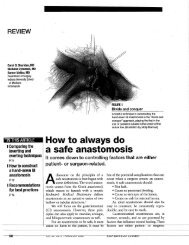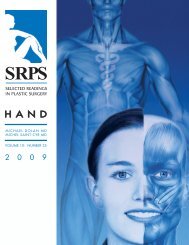Injectables - Plastic Surgery Internal
Injectables - Plastic Surgery Internal
Injectables - Plastic Surgery Internal
You also want an ePaper? Increase the reach of your titles
YUMPU automatically turns print PDFs into web optimized ePapers that Google loves.
SRPS • Volume 10 • Issue 28 • 2010<br />
If possible, patients should discontinue<br />
medications, including herbal supplements<br />
(arnica, garlic, ginger, ginseng, Gingko biloba, St.<br />
John’s Wort, vitamin E, etc.), that might cause<br />
bleeding 7 to 10 days before procedures to decrease<br />
bruising. 107,108 Patients who are taking aspirin,<br />
non-steroidal anti-inflammatory drugs, Coumadin<br />
(Bristol-Myers Squibb, Washington, DC), or<br />
Plavix (Bristol-Myers Squibb and sanofi-aventis<br />
U.S.) might have medical indications for which<br />
the risk of stopping these medications (≤50%)<br />
could far outweigh the benefit. The American<br />
College of Chest Physicians 2008 guidelines<br />
recommend continuance of anticoagulation for<br />
minor dermatological procedures with low risk of<br />
bleeding. 109<br />
INJECTION TECHNIQUES<br />
It is important to realize that practitioners are<br />
performing procedures that implant foreign<br />
materials. Contamination should be avoided to<br />
reduce infectious adverse events. Hands should<br />
be washed. Make-up should be removed and<br />
reapplication delayed at least 4 hours. Skin should<br />
be cleansed before injection. A sterile technique<br />
should be used during reconstitution and dilution<br />
of product. One should consider changing gloves<br />
after intra-oral manipulation. Injection during<br />
active skin infections should be avoided. Use of<br />
the smallest needles to achieve the desired effect is<br />
recommended. 106<br />
The importance of skin preparation with<br />
injectables is unknown. Alcohol cleansing is<br />
commonly performed. Alternatively, Betadine can<br />
be used. Calfee and Farr 110 found no difference<br />
in contamination of blood cultures between 10%<br />
iodine, 70% alcohol, or a combination of the two,<br />
concluding that alcohol be used considering cost.<br />
Chlorhexidine might have the benefit of a residual<br />
antibacterial effect not achieved with alcohol and is<br />
currently recommended for use before placement of<br />
central venous catheters. 111 Of note, chlorhexidine<br />
should be avoided in the periorbital region because<br />
of the associated risk for keratitis. 112 It is important<br />
to remember to spread the skin during cleansing to<br />
14<br />
get into wrinkles. Prophylactic antibiotics have been<br />
suggested to prevent biofilms in situations in which<br />
semi-permanent or permanent fillers are used<br />
initially or later during significant infections.<br />
Topical anesthetics or nerve blocks can be<br />
used, and concomitant injection of local anesthetic<br />
and fillers has been described. 97,98,113 Needle gauge<br />
and length vary depending on the product, dilution,<br />
and application location. Smaller needles might<br />
reduce pain, injection site trauma, adjacent tissue<br />
trauma, and risk of infection. As a general rule, the<br />
smallest needle that allows accurate injection with<br />
optimal results should be used: 30-gauge for less<br />
viscous, 27-gauge for more viscous, such as CaHA,<br />
or 25-gauge for PLLA acid to avoid clumping<br />
or clogging. 106 Lemperle et al. 114 recommended<br />
using a 26-gauge needle, which acts as a guide<br />
to dermal thickness. The outer diameter of the<br />
needle is 0.5 mm, whereas the dermis is two needle<br />
diameters in thickness: 1.0 mm in frown lines<br />
(facial dermis range, 0.4 to 1.2 mm). General visual<br />
clues regarding needle depth include the following:<br />
intradermal, see the gray of the needle; superficial<br />
subdermal, see the shape of the needle; and deep<br />
subdermal, fat is pressed down with the tip of the<br />
needle. 114–116 Arlette and Trotter 117 reported that<br />
despite classic teachings of dermal injection, the<br />
majority of product is found in the subcutis. Several<br />
injection techniques are commonly described (Fig.<br />
5). 118<br />
The serial puncture and droplet technique<br />
deposits small aliquots by using multiple injections<br />
along the wrinkle or fold. Injections are placed<br />
close together to allow the filler to blend into a<br />
smooth, continuous line that lifts the wrinkle or<br />
fold, which can be assisted by molding and massage.<br />
The technique is useful in the glabellar region,<br />
for enhancement of the philtral columns, and for<br />
correction of fine rhytides. It commonly is used in<br />
liquid silicone injection.<br />
Linear threading deposits the injectable as<br />
the needle is advanced (anterograde) or withdrawn<br />
(retrograde). Anterograde injection might be less<br />
painful; theoretically, it minimizes trauma by<br />
hydrodissection and might cause less bruising by






